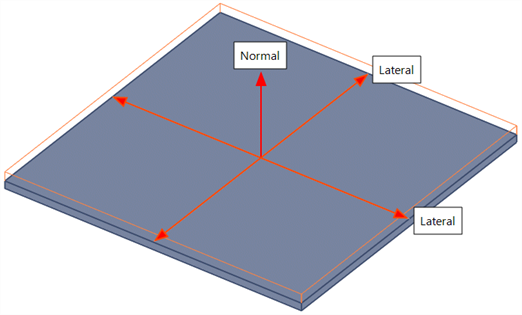Face Attributes: Support

Description
Assigns elastic supports to selected faces.
When the geometry is automeshed, plates created on the face will inherit the face support attribute (see Plate Attributes: Face Support).
Different support attributes can be defined on the -z and +z surfaces.
Face supports can provide normal and lateral stiffness:
- Normal stiffness acts in the direction perpendicular to the surface - that is, in the direction of the local z axis.
- Lateral stiffness acts in shear in the local plane of the surface.

Face support attributes are freedom case dependent.
Dialog
K normal
Normal face support stiffness.
K lateral
Lateral face support stiffness.
Compression-only
If set, the support stiffness is active only when the plate moves towards the support (i.e., the support is active only in compression).
If not set, the support stiffness is active irrespective of whether the plate moves towards or away from the support (i.e., the support is active in both compression and tension).
Compression-only behaviour can only be considered in nonlinear analysis.
The lateral stiffness is not directly affected by this setting. However, if the normal stiffness becomes inactive due to the compression-only setting, the lateral stiffness is also deactivated.
Gap
When a non-zero gap is defined, the support stiffness becomes active only after the plate has moved to close the gap.
The gap may be positive or negative. A positive gap models a plate that is not yet resting on the support; the support becomes active after the plate moves to close the gap. A negative gap means that the plate is already in contact with, and pressed into the support by an amount equal to the magnitude of the gap value; that is, the plate is pre-compressed into the support. In the absence of other loads or constraints, a negative support gap causes the plate to deflect away from the support.
To consider the gap, the support type must be compression-only and a nonlinear analysis must be executed.
The lateral stiffness is not directly affected by this setting. However, if the normal stiffness becomes inactive due to the gap setting, the lateral stiffness is also deactivated.
Limited Bearing Capacity
If set, the compressive normal stress is limited to the specified Max value.
Behaves elastically (i.e., the unloading path is the same as the loading path and there are no residual displacements when unloaded).
Max
Maximum compressive normal stress that can be supported. Used only if Limited bearing capacity is set.
This value is always positive.
Surface
-
+z
Applies the support attribute on the +z surface.
-
-z
Applies the support attribute on the -z surface.
Common Controls
Units
Stiffness: Pressure/Displacement (e.g., Pa/m, psi/in).
Gap:Length (e.g., m, in).
Bearing Capacity: Stress (e.g., Pa, psi).
See Also